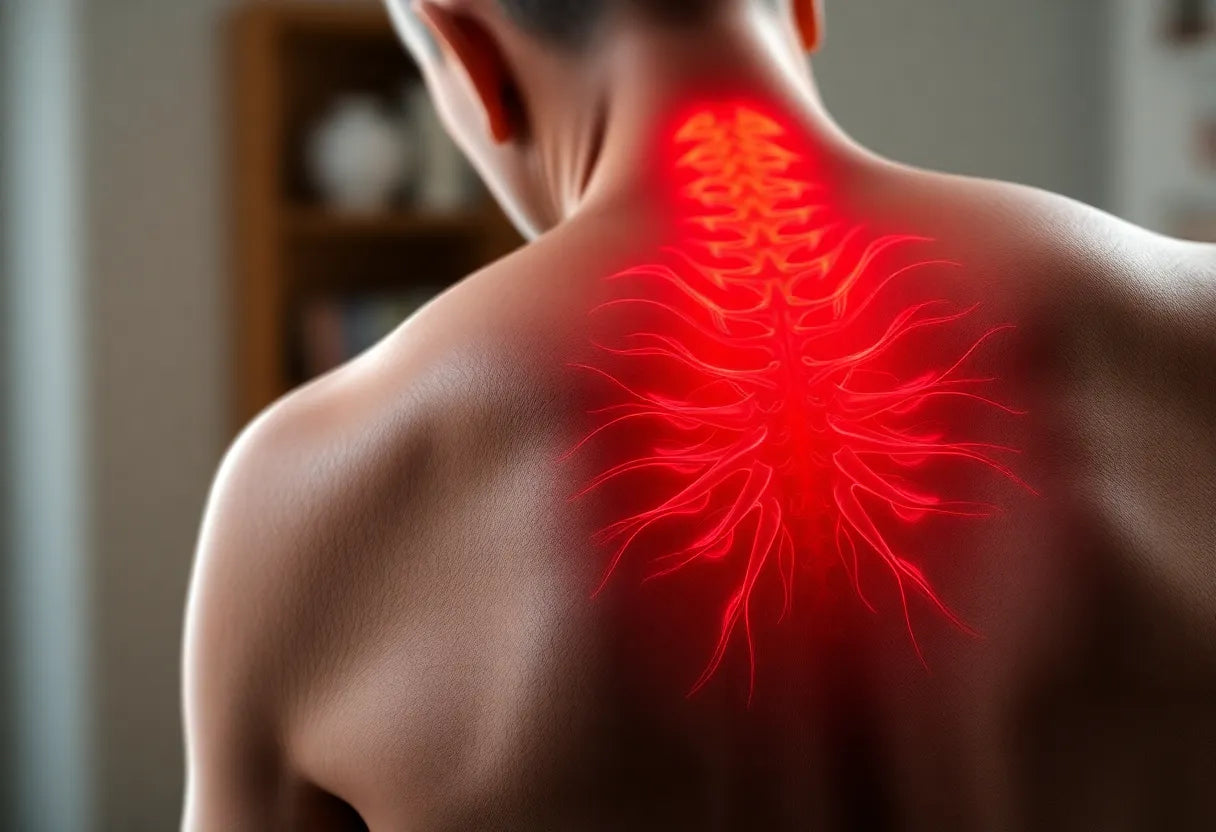Shoulder and arm pain is a common affliction that can significantly disrupt daily life and diminish overall quality of life. Whether it's a dull ache or a sharp, debilitating pain, these symptoms can make even the simplest tasks challenging. From lifting groceries to typing on a computer, shoulder and arm pain can hinder your ability to perform everyday activities. This widespread issue affects people of all ages and lifestyles, driven by a variety of causes and symptoms.
understanding the anatomy of shoulder and arm pain
The shoulder joint is one of the most complex and flexible joints in the human body, allowing for a wide range of movements. It connects to the arm through a network of muscles, tendons, and ligaments, all working in harmony to facilitate motion and strength. However, this complexity also makes the shoulder susceptible to injuries and pain. Understanding the intricate anatomy of the shoulder and arm is crucial in identifying the root causes of pain, which can stem from issues such as muscle strain, joint inflammation, or nerve impingement.
why this post matters
This post aims to shed light on the common causes and symptoms of shoulder and arm pain, as well as explore effective management strategies. By gaining a deeper understanding of these aspects, readers can better navigate their own experiences with pain and take proactive steps towards relief and prevention. Whether you're dealing with a recent injury or chronic discomfort, this guide offers insights into managing shoulder and arm pain effectively. Continue reading to discover practical advice and strategies to help you regain control over your daily life.
common causes of shoulder and arm pain
Understanding the root causes of shoulder and arm pain is essential for effective management and prevention. One of the most prevalent issues is rotator cuff injuries, which include conditions such as tendinitis, bursitis, and tears. These injuries often result from repetitive motion or acute trauma, leading to symptoms like limited mobility and pain during movement. The rotator cuff, a group of muscles and tendons that stabilize the shoulder, is especially vulnerable due to its constant use in various activities.
Arthritis is another common cause, particularly osteoarthritis and rheumatoid arthritis. Osteoarthritis typically affects individuals as they age, causing joint degeneration and pain. Rheumatoid arthritis, on the other hand, is an autoimmune condition that can lead to symmetrical pain in the shoulders and arms. Both forms of arthritis can significantly impair joint function and lead to chronic discomfort.
Additionally, overuse injuries are frequently seen in individuals who engage in repetitive movements, whether through sports or occupational activities. These injuries can lead to conditions like tendinitis and bursitis, which cause inflammation and pain. Trauma, such as fractures, dislocations, and separations, can also result in acute pain and require immediate medical attention.
Lastly, neck-related or radiated pain is an important factor to consider. Issues such as nerve impingement or cervical root problems can cause pain to radiate from the neck into the shoulder and arm, sometimes accompanied by tingling or numbness. Identifying these underlying causes is crucial for effective diagnosis and treatment.
symptoms and diagnosis
The symptoms of shoulder and arm pain can vary widely, depending on the underlying cause. Commonly, individuals experience pain in specific locations, such as the upper arm or shoulder joint, often accompanied by symptoms like swelling, numbness, or a tingling sensation. The quality of the pain can also differ, ranging from sharp and stabbing to dull and aching.
It's crucial to rule out serious conditions that could be causing the pain. For instance, pain radiating from the chest to the shoulder and arm could be indicative of a heart attack, while infections or malignancies, though rarer, require urgent medical attention. Therefore, consulting a healthcare professional is essential, especially when symptoms are persistent or severe.
Diagnosis typically involves a combination of physical examination, medical history evaluation, and imaging tests like X-rays or MRIs. These steps help pinpoint the exact cause of the pain, allowing for a tailored treatment plan to be developed.
management and treatment options
When it comes to managing shoulder and arm pain, there are several strategies available, ranging from self-care to professional interventions. Initially, self-care measures such as rest, ice application, and the use of nonsteroidal anti-inflammatory drugs (NSAIDs) can help alleviate pain and reduce inflammation. These steps are often effective for mild to moderate pain.
For more persistent or severe cases, professional interventions may be necessary. Physical therapy can be highly beneficial, focusing on exercises that improve strength and flexibility. In some cases, corticosteroid injections or surgery might be recommended to address more serious underlying issues.
Incorporating ergonomic considerations into daily life is also vital for both managing and preventing pain. This includes setting up a workspace that promotes good posture and reduces strain on the shoulders and arms. Ergonomic tools, such as adjustable chairs and desks, can make a significant difference in reducing discomfort and preventing future injuries.

Women's Posture Shirt™ - White
Medical-grade shirt activating muscles to relieve pain and improve posture all day.

Men's Posture Shirt™ - Black
Supports healthy posture and reduces shoulder/neck tension throughout daily activity.
By understanding the causes, symptoms, and available treatments for shoulder and arm pain, individuals can take informed steps towards recovery and prevention. In the next section, we'll explore holistic approaches and practical advice for managing pain effectively, ensuring a comprehensive path to relief.
holistic approaches to managing shoulder and arm pain
Embracing a holistic approach to shoulder and arm pain management can significantly enhance recovery and prevention. The biopsychosocial model considers not just the physical aspects of pain but also the psychological and social factors that may contribute to discomfort. This comprehensive perspective encourages lifestyle changes, such as regular exercise, stress reduction techniques, and ergonomic adjustments, to address the multifaceted nature of pain.
Incorporating ergonomic interventions into daily routines is crucial. Adjusting your workspace to promote proper posture can prevent strain on the shoulder and arm. Ergonomic tools, such as supportive chairs, adjustable desks, and keyboard supports, can alleviate existing pain and prevent future issues. Moreover, engaging in regular stretching and strengthening exercises tailored to your needs can improve flexibility and support joint health.
navigating the patient journey from symptoms to recovery
The journey from experiencing initial symptoms to achieving full recovery involves several stages. Early recognition of symptoms is vital, as it allows for timely intervention and prevents further complications. Once symptoms are identified, consulting a healthcare professional for an accurate diagnosis is a crucial step. This often involves a physical examination and imaging tests to determine the underlying cause of the pain.
After diagnosis, developing a personalized treatment plan is essential. This plan may include a combination of self-care strategies, physical therapy, and, if necessary, medical interventions like injections or surgery. Throughout this journey, maintaining open communication with healthcare providers ensures that treatment is adjusted as needed, promoting a smoother recovery process.
visual aids and educational tools
Utilizing visual aids and educational tools can enhance understanding and management of shoulder and arm pain. Interactive pain diagrams help individuals pinpoint specific areas of discomfort, facilitating more accurate self-assessment. Online self-assessment quizzes can guide users in recognizing symptoms that require professional evaluation.
Video demonstrations of exercises and ergonomic setups offer practical guidance, making it easier to implement recommended changes. These resources empower individuals to take an active role in managing their pain, promoting a proactive approach to recovery and prevention.
frequently asked questions
What are the early signs of rotator cuff injuries?
Early signs of rotator cuff injuries often include shoulder weakness, pain when lifting the arm, especially during overhead activities, and difficulty sleeping on the affected side. If these symptoms persist, it is advisable to seek medical evaluation to prevent further damage.
How can I differentiate between arthritis and other causes of shoulder pain?
Arthritis-related pain is often characterized by stiffness, swelling, and a gradual onset. In contrast, pain from injuries like rotator cuff tears may be more acute and linked to specific movements. Consulting a healthcare professional is essential for an accurate diagnosis, as they can assess symptom patterns and recommend appropriate tests.
When should I seek medical attention for shoulder and arm pain?
Seek medical attention if you experience severe pain, an inability to move the arm, or symptoms indicative of a heart attack, such as chest pain radiating to the shoulder or arm. Persistent pain that does not improve with self-care measures also warrants professional evaluation.
Can ergonomic aids really help with shoulder and arm pain?
Yes, ergonomic aids can significantly help by supporting proper posture and reducing strain on the shoulders and arms. Tools like ergonomic chairs, adjustable desks, and wrist supports can alleviate discomfort and prevent further injuries, contributing to overall pain management.
What lifestyle changes can help prevent shoulder and arm pain?
Incorporating regular exercise, focusing on strengthening and flexibility, can prevent shoulder and arm pain. Improving posture, especially during prolonged activities, and using ergonomic equipment are crucial. Additionally, managing stress and ensuring adequate rest can support overall musculoskeletal health.
Källor
- UCI Health. "Shoulder, Arm and Hand Pain."
- StatPearls. "Shoulder Pain and Common Shoulder Problems."
- Mount Sinai. "Shoulder Pain."
- Versus Arthritis. "Shoulder Pain."
- MedlinePlus. "Shoulder Pain - Overview."
- Mayo Clinic. "Shoulder Pain: Causes."
- American Academy of Orthopaedic Surgeons. "Shoulder Pain and Common Shoulder Problems."
- Penn Medicine. "Shoulder Pain."


















